How to make a small Newtonian Telescope
I take you all the way through the process of making a small newtonian
It really isn’t that difficult and with a little bit of know-how and a few parts you can make yourself quite an impressive little telescope in the newtonian style. This is a three part series and in the first part I show you the basics of how we make the telescope and I actually put together a little sample setup so you can see how it works. There is a video showing all of this at the bottom of this page.
There isn’t a whole lot to a newtonian telescope. Just a few basic parts like the primary mirror and the secondary mirror. But, when it comes to making the telescope there are a few things you have to be careful about. First, everything has to align up very accurately. The mirrors/eyepiece light path has to be nice and straight. And second the tube and the mount have to be pretty sturdy.
The tube has to hold everything in place pretty accurately and the mount for the scope has to be reasonably sturdy and steady so you get images that are not shaky. You have to remember that you are magnifying images so anything like shake or vibration will also be magnified!
Just keeping these things in mind while we are building will help you make a useful telescope.
The light path and the optical assembly
First lets take a look at something called the “OTA” or “Optical Tube Assembly” of a newtonian telescope. It is a pretty simple thing and it will show us the light path inside this telescope and how we need to build it.
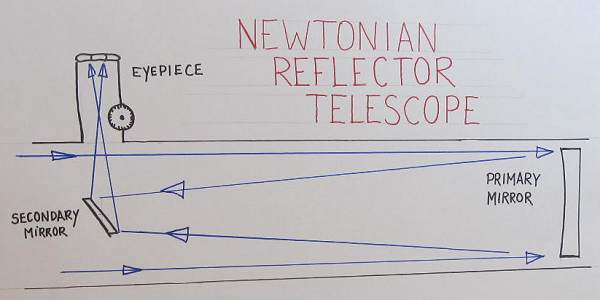
So that picture above shows the light coming in from the left. The stars are that way. The light goes down the tube and bounces off the mirror. The mirror is concave so it bends light into a cone. That cone of light travels to our secondary mirror. That mirror is at a 90 degree angle and it bounces the light out the side of the telescope to the eyepiece. Pretty much as simple as that!
The primary mirror gathers lots of light. The secondary mirror bounces it to the side so we can see it.
And the eyepiece magnifies and focuses the light.
And here is that setup in a very open configuration so you can see it all. It is all secured to a long board. I did this so you can see it all very clearly and so I can work out all the specifics of making the telescope. This will help me a lot in quickly and easily doing this tutorial.
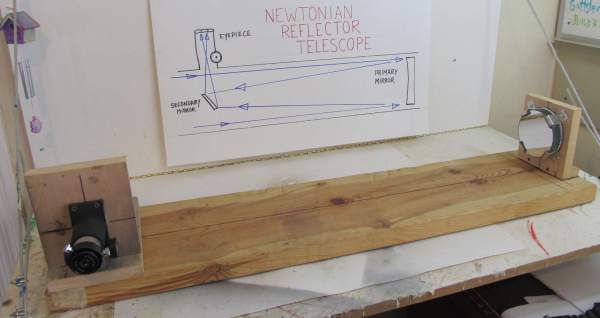
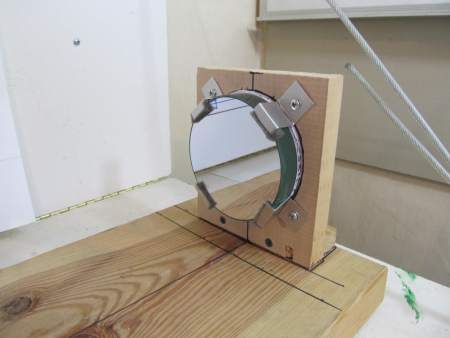
Here is a look at the primary mirror.When mounting the primary mirror there are a couple of things to consider. First, it has to be very secure so it doesn’t more around. I used small metal clips and there is a small piece of foam under each clip. This is to protect the surface of the mirror from scratching or damage.
The mirror of a telescope is not like a normal mirror. Normal mirrors have the shiny surface painted on the back of the glass. But a telescope mirror has that shiny aluminized surface coating right on the front. This is so you don’t lose light through the glass. It makes a difference. But that also means that the surface is very delicate. So, handle it with extreme care!
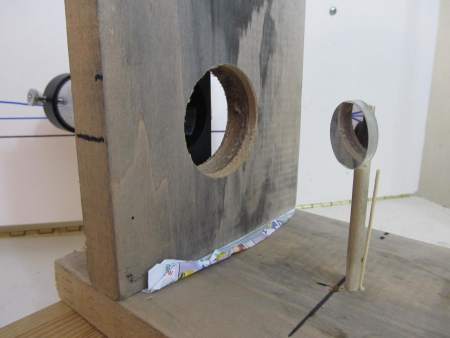
Now let’s take a look at the secondary mirror. This is the little mirror that reflects the light out to the side of the telescope. It also is coated on the front surface so it is also delicate. Notice how I have a single peg holding it in place. You want to hold it in place with as little material as possible. thing metal bands would be great. This is so you don’t block much light that is traveling down the tube.
This little mirror itself already blocks some of the light so we want to just keep the light blocking to a minimum as is possible.
Okay, so that is the basic setup of the optical tube assembly. Not a whole lot to it. You can watch the video below to see it in action and even look through the eyepiece. Next we are going to cover more of the actual building of the telescope and mount. That’s coming soon!
Let’s continue on and make the Telescope tube (also called the Optical Tube Assembly)
RESOURCES
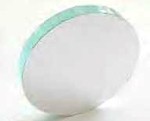 If you are considering making a telescope just like this one with the 4.25 inch mirror here is a link to the place where I got mine. It also comes with the diagonal mirror which is a nice thing to have. It it the 4 1/4″ finished mirror kit on this page here: Newport Glass
If you are considering making a telescope just like this one with the 4.25 inch mirror here is a link to the place where I got mine. It also comes with the diagonal mirror which is a nice thing to have. It it the 4 1/4″ finished mirror kit on this page here: Newport Glass
